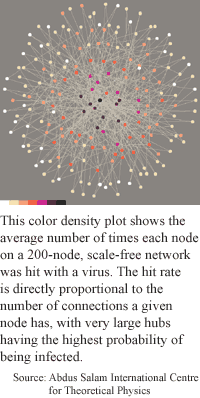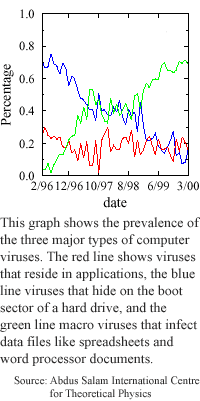
Net inherently virus prone
By Kimberly Patch, Technology Research NewsThe Internet's sheer size and large central hubs make it an efficient communications network, but those same traits make it vulnerable to the uninvited bits of code that are the computer's equivalent of biological viruses.
Two physicists have applied their understanding of condensed matter physics, which examines the complex, collective behavior of matter, to mapping how viruses traverse the Internet's complicated labyrinth of connections.
What they have found is that the Internet's efficient communications structure may make it vulnerable to even the weakest of viruses.
Standard epidemiological models look at how virulent biological viruses are. The more virulent, or easily spread a virus is, the larger the risk that it can spark an epidemic. If the virulence falls below a certain threshold, however, the infection will die out exponentially fast and therefore cannot spread fast enough to become a threat.
In order to study virus spread within the Internet, the physicists took into account the network's scale-free structure. The Internet harbors a few extremely large hubs, or nodes with huge numbers of connections and, many nodes with only a few connections.
In contrast, the hubs in social connections are more limited in size. "Real viruses can be transmitted only by close physical contact, and so diffuse in the community in a series of short hops between infected and uninfected individuals," said Alessandro Vespignani, a research scientist at the Abdus Salam International Centre for Theoretical Physics in Italy. "The crucial difference is that computer viruses spread on the Internet, which has a very special branching structure so on the Internet viruses can always pervade the system,” he said.
The researchers found that this type of structure allows the epidemic threshold to fall below zero, meaning that no matter how low a virus' virulence, it won't necessarily die out. "Strikingly, we found that the Internet lacks any epidemic threshold. The Internet is prone to the spreading and the persistence of infections [no matter how low their] virulence," said Vespignani.
The Internet's structure also explains why computer viruses affect only portions of the Internet. Despite spreading easily and being able to survive for a long time, any single virus has a low probability of infecting the bulk of the Internet, according to the researchers.
Ironically, "the ideal world for data sharing and fast communications... is also an ideal environment for viruses, which easily find... ways to rapidly infect new hosts through the intricate digital highways," he said. "The connections between computers on the Internet have enormous fluctuations and intricate structure that has to be included in the theoretical and experimental study of digital epidemics."
The lack of a threshold is surprising and potentially important for other scale-free networks as well, said Albert-László Barabási, a physics professor at Notre Dame University.
Network models have until now shown that viruses invariably die out if they're not too contagious, said Barabási. "However, [these models were] based on... outdated ideas on the topology of real networks," he said. In recent years it has become increasingly clear that many networks, including the Internet, are scale-free and have inhomogeneous topologies dominated by a few highly connected hubs, he said.
The lack of a threshold for virus spreading in scale-free networks "is highly unexpected and it will have a significant effect on a number of fields," said Barabási.
The model could be used to understand epidemic dynamics in scale-free networks like "food webs, power grids and social networks," said Vespignani. It could also be applied to problems like the spread of polluting agents, he said.
There's another issue worth looking at that may make understanding how computer viruses spread more complicated, however, said Jon Kleinberg, an assistant professor of computer science at Cornell University. "It's a subtle issue. What is really the network on which these viruses spread?" he said.
Instead of the full, scale-free network of the Internet, many computer viruses actually spread on subsets that look more like social networks that have limitations on how large a hub can be, he said. It is very common, for instance, for a computer virus to spread by sending itself to the e-mail addresses listed in an infected machine's address book.
While the large, central hubs on computer networks can have tens of thousands or even millions of connections, the size of even the largest e-mail address books are limited. "The real network on which viruses spread is an invisible network of who talks to whom sitting on top of the Internet, and that's a network that we have less ability to measure at the moment," said Klineberg.
The researchers are fine-tuning their models to see how effective things like immunization could be on the Internet. "We're introducing more details and realism in the model. For instance, we're considering the presence of immunization, latency times, [and] detailed Internet maps," Vespignani said.
The researchers are headed toward a general theory of epidemiology and complex networks, he added. Such a model could help in devising algorithms to protect the Internet from a virus epidemic, he added.
Ultimately, the Internet needs a global immunization organization in order to establish the optimal policies of immunization and antivirus implementation, said Vespignani. "We claim that the Internet needs a digital immune system... that automatically detects and submits viruses to some central control laboratory," he said.
Vespignani's research colleague was Romualdo Pastor-Satorras of the Polytechnic University of Catalonia in Spain. The research was funded by The International Centre for Theoretical Physics, the Polytechnic University of Catalonia, the European Community Network and the Spanish Ministry of Education and Culture.
Timeline: Not Available
Funding: Government, Private
TRN Categories: Internet; Networking; Cryptography and Security
Story Type: News
Related Elements: Technical paper, "Epidemic Spreading in Scale-Free Networks," scheduled to appear in the April 2, 2001 issue of Physical Review Letters and is posted on the Computing Research Repository (CORE): http://arXiv.org/abs/cond-mat/?0010317.
Advertisements:
March 21, 2001
Page One
Net inherently virus prone
Rubber stamp leaves electronic mark
Software spots forged signatures
Magnetic transistor means changeable chips
Filters distill quantum bits


News:
Research News Roundup
Research Watch blog
Features:
View from the High Ground Q&A
How It Works
RSS Feeds:
News
Ad links:
Buy an ad link
| Advertisements:
|
 |
Ad links: Clear History
Buy an ad link
|
TRN
Newswire and Headline Feeds for Web sites
|
© Copyright Technology Research News, LLC 2000-2006. All rights reserved.